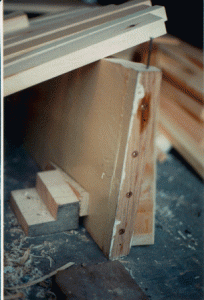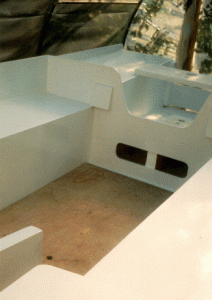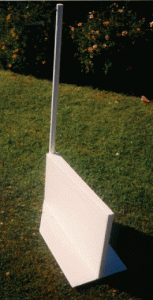Chebacco News
Number 5, September 1995
It’s time, once more, to report on Chebacco-related news around the world. The weather here, in the UK, has been superb – four weeks of continuous sunshine and counting! No excuses, then for lack of progress in outdoor boatbuilding.
We’re on the Internet!
As I mentioned last time, I was trying to get a World-Wide-Web page set up with Chebacco News in it. It’s there now. The address to connect to is:
http://www.tay.ac.uk/mcsweb/staff/wbs/chebacc4.html
for newsletter number 4, and
http://www.tay.ac.uk/mcsweb/staff/wbs/chebacc5.html
is this one.
Another internet ‘club’ that should be of interest is ‘Bolgerphiles’. If you’d like to participate, drop an email to
cnoto@freenet.scri.fsu.edu
who, in real life, is Chris Noto, of Sweetwater, Tennessee.
Some of you have already found Chebacco News on the net and have told me they don’t need me to send out the newsletter to them any more. This is fine, and saves on printing costs and stamps BUT all readers of the News should feel part of the ‘club’, whether they read the electronic version or get the paper copy in the mail. I’m interested to hear from you however you come to be reading this.
Anchors, toilets, mast jackets, . . .
Phil Bolger mentioned in a recent letter that he would favour a plough anchor – Bruce or Delta for example weighing 25 pounds or more with 200 feet of rode, for a Chebacco. I’ve had letters from a couple of you wondering if I had come across a good way to stow an anchor on board a Chebacco. To my mind the foredeck is rather small to accommodate a hatch, so although the anchor could be stowed up in the forepeak the dirty weedy thing would have to be brought through the cuddy, dripping on your nice floor or sleeping bag!
Personally, I don’t think the forepeak of a light displacement boat is the best place to hold anything heavy. The nearer the anchor and other heavy gear is to the centre of the boat, the happier I am. My plan is to keep the anchor(s) under one of the side benches, getting it in and out through the access hole from the cuddy through bulkhead 4, and the rode on the other side to balance things out. Admittedly, it will drip momentarily in the cuddy but this should be a minimal problem considering the short distance from the access door to the cuddy entrance.
Another possibility you may like to consider is to replace the ‘Jonesport’ cleat at the stemhead by a short bowsprit/cathead to support a plough anchor ready to drop at all times.
If you have any other ideas, we’d like to hear them!
Jim Slakov asked about the anchor, and also about where to keep a portable toilet. He also wonders if anyone has thought about how to arrange a mast jacket. Do you favour mast hoops or lacing for the luff of the mainsail? Again, let us hear your ideas on these or other matters of interest.
How much does it cost?
People embarking on the building of a Chebacco wonder how much it’s all going to cost. I’ve had a couple of letters about this and thought the answer might be of general interest.
The cheapest way to go is to use exterior-grade ply. In the UK this will set you back about £500 ($800) for the 22 sheets needed if you follow Phil’s drawings to the letter, including hollow keel and ply floorboards. The 10 gallons of epoxy needed cost £750 ($1100) in the UK, and the glass cloth £200 ($350). If spars are made from reclaimed wood the cost is negligible. Fittings vary a lot, but making as much as possible yourself (wooden cleats etc) you can probably get away with £200 ($350). The sails would cost about £600 ($1000) ready made, but you can buy the cloth to make them for £130 ($200). Paints and varnish (house paints) will cost about £100 ($160), giving a grand total (assuming home-made sails) of £1880 ($2960) very approximately.
Going the Rolls Royce route with Bruynzeel ply and pricey paints, top class sails and so on could easily set you back four times that much. A lot depends on whether you are building her to sail yourself for the foreseeable future, or are more interested in her resale value when you move on to your next boat.
My own approach was to try to spread the cost as much as possible, so as not to have to shell out too much cash at once. As a result, the ply I’ve used is of a very modest marine grade, but I’ve gone to town on the best paints and varnish (2-part linear polyurethanes) which, unlike the ply, can be bought as and when required. Hopefully, too, they’ll provide good protection for the ply, such as it is.
Depending on how you intend to sail her, you may want to buy a trailer ($1500 or more) and an outboard motor ($800, but second hand motors are often available much more cheaply).
We have a sailor!
At last, a Chebacco sailor (as opposed to builder/dreamer/. . .) has joined our ranks. Alessandro Barozzi of Valfenera, Italy owns a Chebacco built by a builder named Casavecellia. My Italian is very rusty (- it never was shiny -) but I gather from Alessandro’s letter that his Chebacco is the lapstrake version, rigged as per the plans, but built as an open boat, without the cuddy [Alessandro – please correct me if I’m wrong!].
He writes that members of his club describe her as ‘a poem – the most elegant boat on Viverone’s pond’. ‘Nencia’ (for that is her name) nearly came to grief in a ‘Valdostano’ – a powerful wind sxweeping down from Mont Blanc – when she broke away from her mooring and blew away towards the rocky lee shore. Fortunately, she ended up in a quiet corner, bobbing around with some black ducks and only a little scratch on the paintwork to show for her adventure.
Alessandro mentions that she has some weather helm, and is thinking about adding a jib to help her balance better. He also finds her slow to tack, but I suppose this is understandable given that she has a long shallow keel, unlike a conventional centreboard dinghy. Finally, he says that she sails well, with satisfying speed, even in the lightest wind. ‘
Nencia’ is Casavecellia’s second Chebacco. The first one he built was strip planked, Bermudian rigged, had an iron centreplate and an inboard diesel engine (if I understand the Italian technical terms correctly). Alessandro believes that it was a mistake to stray so far from Phil Bolger’s drawings, and made sure that his own craft was much closer to the designer’s intentions.
A Tender for a Chebacco.
As my sheet ply Chebacco nears completion I’ve started to ponder the practical aspects of sailing her. I’ll be keeping her on a deep-water mooring in the Tay estuary and may be a couple of hundred yards from the nearest launching slip for a tender. This can be a fair old distance to row when wind and tide are unfavourable. I wrote to Phil Bolger asking if a stretched ‘Nymph’ might be suitable. He replied suggesting that
[The June Bug] is the best tender design that I know of if you can live with its looks: fast rowing, quick to build, a good carrier and stiff to get into and out of (a weakness of Nymph). Weight about 100 lbs. They’re good sailors, but the rig is too much clutter in a tender.
I also asked him about how a Chebacco would row, if caught out in a calm with a busted outboard (or no outboard at all). He replied:
I imagine a Chebacco would row quite well with, say, nine-foot oars. They have little if any more surface than a Dovekie, which I’ve rowed many miles at three knots. Chebacco’s geometry would not be as good, and think out carefully where you will stow the oars! I would have a long paddle, actually probably a six-foot oar. . . . If you tow the 14-foot tender, you can row that . . .
Windward Performance
You’ll recall that Mark Raymer was considering building a Chebacco-25, but was worried about how well she’d sail to windward. Phil writes:
On the windward performance of the Chebacco-20, it is as good as the sails, which need to be cut with a good flow. Given that, they are close-winded and spirited. The 25-footer is no doubt undersparred for light weather, when she is supposed to use the engine without inhibitions. I’m most confident that she will give a good account of herself in any fair sailing breeze, and that the speed with which she can be rigged and unrigged will add more to her mileage than would a better drifting ability.
My own view is that close-windedness is a matter of what you’re used to, and whether you intend to sail in company with more close-winded boats. For example, I don’t think that Chebacco was ever intended to sail close-hauled with a heavily ballasted fin-keeled bermudian sloop with a bendy mast. I currently sail a 15 foot lug-rigged flattie. I’m always contented with her performance when I sail alone. I sometimes sail in company with racing dinghies like Wayfarers and Enterprises and while the flattie gives a good account of herself on a run or a reach, she’s soon left behind on windward legs. Having said that, I wholeheartedly agree with Phil about rigging time – I can be on the water and away 20 minutes before the racers, which makes up for a lot!
Thanks to those of you who wrote to me about this. I have passed your letters on to Mark.
Fraser’s Stripper
Fraser Howell of Nova Scotia is making excellent progress with his strip-planked Chebacco hull. He writes:
As of today the strip bottom is complete except for the veneer, which is next. I lost some time due to moisture. I was building upright, outdoors. We had some exceptional rains, and the pine strips had warped, mostly I think because of moisture from the ground, as it was under a waterproof cover, with no floor. I moved it to my shed a week ago , and happily the original dimensions returned (whew). Everyone who the bottom out of plywood was right. My method is not cheaper, and requires probably ten times more work. If there is an advantage it is that the final bottom thickness will be one inch. said to make
Given the bottom, here is the sequence I plan to follow;
1. loft and cut molds out of inexpensive plywood sheathing for every station, except transom and #5 which are made from good marine ply
2. make c.b. case, again from good marine ply
3. align the molds and stem on the bottom with the c.b. case inserted in #5, #6
4. brace the molds and epoxy the c.b. case and #5 together, permanently attach stem, #5 and transom to the bottom
5. strip plank the hull
6. turn it over, smooth the hull and apply 1/8″ veneer in epoxy
7. smooth the veneer layer, coat with epoxy
8. turn it back over . . .
I have laminated and roughly bevelled the stem, framed the centerboard case, and completed half of the molds. Having a great time. I got Bolger’s latest book, enjoyed ot a lot.
Looking forward to an exuberant description of the sailing performance.
Fraser also enclosed some detailed sketches of how things are to go together. I’m afraid they are a bit beyond my Microsoft Paintbrush ability, so I’ll summarise what they are about:
The c.b. case has a really neat frame – the for’ard part is made from a straight piece of wood, slit lengthwise several times by bandsaw, glue put in the slits and the whole lot bent to shape forming a strong, laminated member.
The strip planking is to start from the chine, with the first plank being glued to the edge of the bottom. Fraser has cut a set of little bevel guides from the lofting so that the edge is accurately bevelled to accept the first plank.
The strips will be scarfed on the boat with Titebond glue and galvanised finishing nails.
The c.b. case will be finished flush with the pine strips on the outside of the bottom and the edge grain of the ply covered by the 1/4″ ash veneer. The cheek pieces of the keel are made of solid ash and are through-bolted to the logs either side of the c.b. case inside the hull.
There is a mold at each lofting station – not just at bulkhead positions.
There are some photos later . . .
Gil’s Boat
Gil Fitzhugh is making good progress with his lapstrake Chebacco-20.
All the planks are permanently in place, and I’m sanding, filling, sanding, epoxying, sanding, . . . Maybe another couple of weeks and I can paint the hull. The I’ll dragoon some neighbors, ply them with beer and flip the boat. Working outside in the spring and summer gives new meaning to WoodenBoat’s euphemism about building from ‘organic materials’. There’s the bark, twigs, dead leaves and seed pods that land on the work. There’s the flies, spiders, inchworms (2.54 cm worms) [Gil’s practicing, in case ‘The Boatman’ asks him to write an article] that crawl on it. There’s gypsy moth larvae, that feast on leaves and excrete little pellets on everything. All this organic material gets caught in the crevices, or lands in wet epoxy, and leaves residue in the boat. Some of it is, at best, wood by-products. And some is two or three incarnations away from having recognisable vegetable origins.
How much of my $70/gallon epoxy ends up as sanding dust?
[Gil should count his blessings – epoxy costs £75/gallon on this side of the pond!]
And finally
Keep your letters and emails coming. These form the substance of this newsletter. Remember that what may seem obvious or mundane to you could light the way for someone else. Jim Slakov writes:
Keep up the great work: newsletter #3 was the best yet. Of special interest to me was Gil’s method of planking, and the pictures of the two Chebaccos. You wouldn’t believe how I obsess over every detail, especially Story’s version: I like a bit of wood showing, and his lower hatch slide-logs, although that extra height looks good in Bolger’s drawings . . .
Write to me, Bill Samson, with your thoughts, experiences, ideas, dreams, . . .
Bill Samson,
88 Grove Road,
West Ferry,
Dundee, DD5 1LB,
Scotland.
email: w.samson@tay.ac.uk
Photos
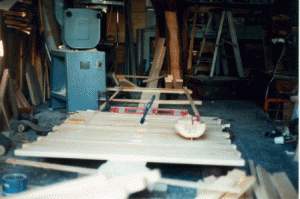
The bottom of Fraser Howell’s strip-planked Chebacco – note the screw caddy!
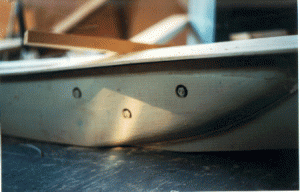
For’ard end of Fraser’s keel cheekpieces
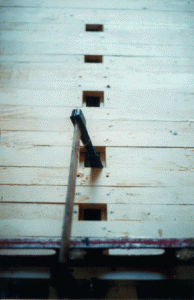
Planking in way of centerboard case
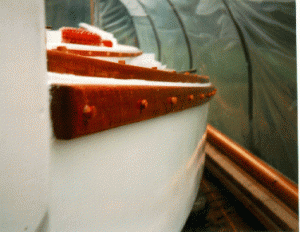
Bill Samson’s Chebacco – screw hole plugs to be trimmed.
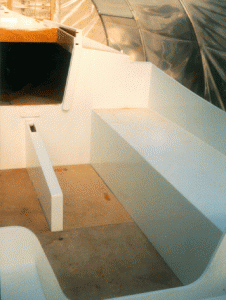
Bill’s boat, cockpit looking for’ard.

